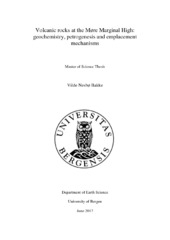| dc.description.abstract | The opening of the Norwegian-Greenland Sea at the Paleocene−Eocene transition was accompanied by extensive magmatic activity, giving rise to the North Atlantic Igneous Province. The magmatic activity is today manifested along the conjugate Norwegian and Greenland continental margins. In 2014, the Norwegian Petroleum Directorate targeted a unit seen as prograding reflectors in the seismic record along the outer mid-Norwegian Margin by drilling. Approximately 40 m of igneous rocks were recovered from the shallow borehole 6403/1-U-1 at the northernmost part of the Møre Marginal High. This study presents the first documentation of ignoeus rocks from this poorly studied part of the Norwegian Margin. Based on detailed logging, petrographic and geochemical analyses, and interpretation of seismic lines over the study area, the study ads new elements to the understanding of the magmatic evolution of the Norwegian Margin. It is documented that the volcanic succession consists of brecciated material, comprising hyaloclastite and incorporated microcrystalline basalt clasts, and interlayered coherent lava flows. These are interpreted to represent the deposits formed during the build-out of a lava delta system. The findings confirm that the prograding reflectors have a volcanic origin. The cored volcanic succession has relatively uniform petrography and geochemistry, and it is exclusively composed of tholeiitic basalts with a MORB-like character. The basalts show affinities to other igneous rocks from the Vøring Marginal High, SE Greenland Margin and Jan Mayen Ridge, emplaced during the rift-to-drift transition. Geochemical modelling of rare earth elements, and of Nd and Hf isotopic compositions, along with enrichment in selective incompatible elements, provide evidence that the succession has experienced crustal contamination. Based on geochemical modelling, the melts are interpreted to originate from a mantle source more depleted than typical N-MORB sources. Seismic evidence reveals that the succession formed prior to ~56 Ma, probably in the Late Paleocene. | en_US |
